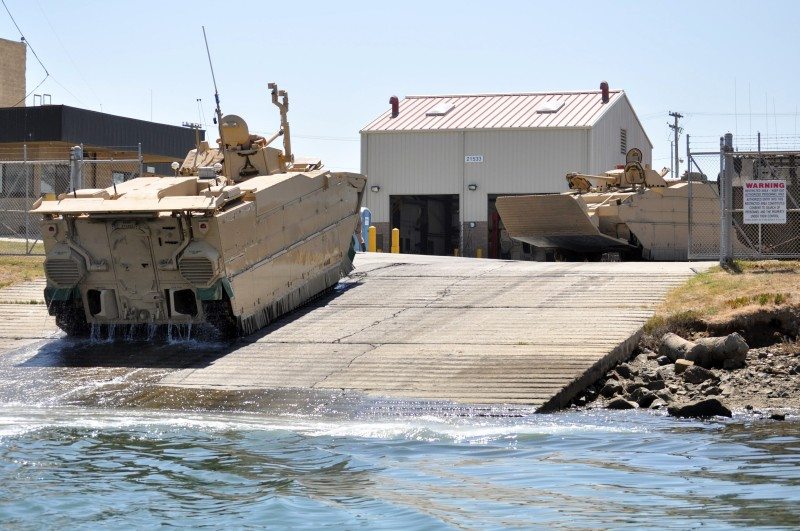After the Secretary of Defense cancelled the Expeditionary Fighting Vehicle in January, sighting the project was taking too long and the costs exceeded expected amounts, the Commandant of the Marine Corps, Gen. James Amos, recently stated he would be driving a working replacement for the EFV before his term was up.
Now members of the Fires and Maneuvers Integration Division at Headquarters Marine Corps Combat Development and Integration Command aboard Quantico are working feverishly to make the commandant’s goal a reality.
Three different vehicle programs will replace the responsibilities the EFV would have held, said Kevin McConnell, the deputy director of Fires and Maneuvers Integration Division. The Assault Amphibian Vehicle Service Life Extension Program, the Marine Personnel Carrier and the Amphibious Combat Vehicle are being developed to be a less costly replacement for the EFV.
While the EFV would of cost an estimated $16.8 million a unit, the ACV is estimated to cost $10-12 million, the MPC $4.5 million and the AAV is still under evaluation.
Separate plans from the EFV have been in place for both the AAV SLEP and MPC since 2005, McConnell said.
“Until the ACV is fielded, the AAV will continue to provide the fully amphibious, self-deploying, armored combat vehicle capability required for the [Marine Air Ground Task Force] in support of amphibious operations and sustained operations ashore,” said Kurt Koch, the combat vehicle capabilities integration officer for Fires and Maneuvers Integration Division.
Upgrades will begin to be implemented on the AAV SLEP in 2012 and not finished until around 2021.
“At a minimum the AAV will receive upgrades to increase its survivability and force protection capacity,” Koch said. “Probable related improvements to the vehicle include integration of a modern power-train and higher capacity suspension components to maintain required performance levels, as well as improve reliability.”
The MPC will be a compliment to both the AAV and in the future ACV, as a wheeled armored personnel carrier, said McConnell.
“The MPC will reside in the Assault Amphibian Battalion,” Koch said. “It possesses the capability of negotiating water obstacles in support of the task force maneuver and provide a high degree of all around protection in a highly mobile, balanced medium armored personnel carrier platform.”
The MPC can conduct operations ashore in both open and restrictive terrain during operations in permissive, uncertain and hostile environments, Koch said.
“We already have a demonstration vehicle,” McConnell said. “We plan to start making our final version of it in 2013, and see them operational in 2018.”
But the future of amphibious assault resides with the ACV.
“You heard the commandant say he will drive a vehicle before his term is done,” McConnel said. “Our challenge is how do we resolve that. We have a solid plan in place. We will have a technical demonstration vehicle completed by the end of FY12 that will give us an idea of the real of possibilities for this project. Then we will work to have a fully operational demonstration vehicle done by the end of 2013 or 2014.”
As a replacement for the AAV, the ACV will be operationally mobile in the water, capable of ship-to-objective maneuver from over the horizon, Koch said. The ACV must be highly mobile on land also in order to support the Ground Combat Element based maneuver task force. It must be lethal in the assault and capable of carrying the reinforced rifle squad through the surf, over natural and manmade obstacles and into the attack. The ACV must be sufficiently protected in order to be effective across the full range of operations.
“Of course these are the plans and nothing is written in stone,” McConnell said. “These plans haven’t even been approved yet. They just help us get in the right mind set of where we need to be.
“After our technical demonstration vehicle is completed, we will allow for a competition between contractors,” McConnell said. “We will give them three or four years to build their own model and then we will choose one or two contractors to carry on the program to its completion, around 2020.”
Changing the direction of the Marine Corps’ amphibious assault is not an easy task and requires patience to ensure it’s done right, McConnell said.
“All of these programs are on relatively aggressive schedules,” McConnell said. “It takes a lot of coordination between the Marine Corps, Secretary of Defense and other stake holders to make this happen quickly and successfully. We all want to make this happen and we here to see this project through.”










